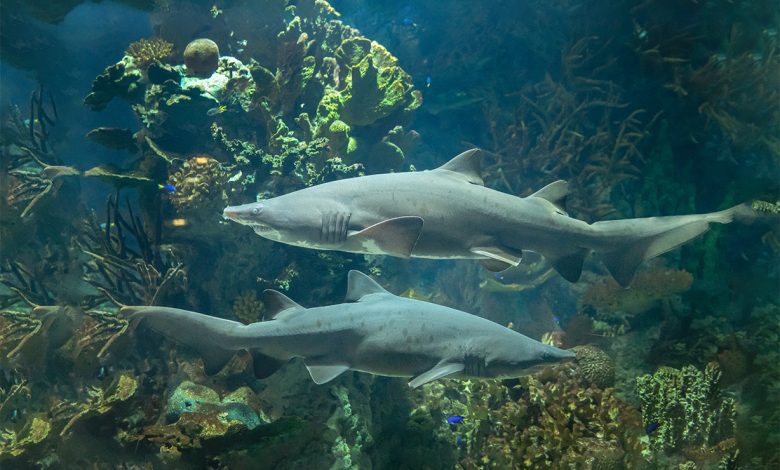Sand Tiger Shark Conservation Efforts
A new international achievement for The Scientific Center Kuwait

The Scientific Center Kuwait (TSCK), one of the centers of the Kuwait Foundation for the Advancement of Sciences (KFAS), announced a major global scientific achievement with the successful breeding of the endangered Sand Tiger Shark. A first-of-its-kind achievement for the center, this new milestone sets TSCK apart as one of a few centers in the world to have successfully bred this endangered species. To celebrate the scientific feat, TSCK held a press conference on July 5, 2022, in the presence of several representatives of major institutions, entities, and key figures in the world of environmental sciences, preservation, biodiversity and sustainability. At the conference, the attendees were able to see the baby sharks for themselves, who have now become part of the group of Sand Tiger Sharks that the Center has cared for now for more than 20 years – becoming one of the most popular marine creatures at TSCK.
The famed Sand Tiger Shark, Bibi, who is estimated to be more than 20 years old herself, gave birth to the new baby Sand Tiger Sharks, one male and one female, on January 24, 2022, at TSCK Aquarium. The baby sharks were named Bader and Badriya, a choice made by the public via a vote held on TSCK’s Instagram account.
Salam Al-Ablani, a biologist and a former member of the TSCK Board of Directors, said that TSCK was able to provide and maintain a suitable environment for Sand Tiger Sharks that enabled them to reproduce naturally and continuously without any artificial interference during those years. According to scientific studies, this type of shark is one of the rarest species that breeds in aquariums, due to various stressors such as crowding, diet, and water temperature. The gestation period of females ranges from 12 to 14 months, and it is difficult to maintain her pregnancy for this length of time under all the factors inside an aquarium’s environment. The birth of healthy youngsters also indicates that the nutritional value of the sharks’ diet is very high, which is reflected very positively in the excellent breeding practices of the Marine and Wildlife Department staff and their expertise, not to mention the management of TSCK.
وأكمل العبلاني: كان أكبر تحدٍّ للمركز العلمي هو ضمان حياة صغيري القرش بعد ولادتهما؛ إذ تحتاج قروش النمر الرملي إلى عناية فائقة حتى تستطيع النجاة. لذلك نجد من الصعب جداً تكاثرها، وإن نجاة هذا النوع من القروش تعتبر أمرا نادراً، والنماذج الناجحة شحيحة جداً.
Once the birth took place safely, the Aquarium team, led by Global Consultant Andrew Clarke, rushed the youngsters out of the main tank in time, where they were transferred to the nursery ponds to ensure their safety – and where they were closely monitored for all aspects, especially their feeding. The team then put in place a strategy to take care of the newborns and ensure their proper growth, by providing the right amount of food they need at the right time.
About Bader and Badriya’s condition, Al-Ablani said: “The baby sharks are in excellent health. Each one of them weighed about 3.5 kg at birth and began to feed about five days after birth, which is the norm for this type of shark given that they are born with egg yolks and the remains of the fetuses they ate during the gestation period in their stomachs. At the age of four months, the youngsters weighed about 9.5 kg and reached a length of about 130 cm. Currently the Center’s specialized staff carefully weighs the amount of food they are fed, to be able to track how much each of them consumes, and we use this information to determine their growth rates. We also collect morphometric measurements (weight and height) monthly.”
Al-Ablani continued: “These sharks have great ecological importance and value in maintaining the marine biobalance, as well as scientific value in terms of what they mean for the field of scientific research. With this information, we will learn more about Sand Tiger Sharks, and will help other facilities around the world that struggle to breed and nurture them. We can also use this information to better understand their natural history, and help provide vital information about some of the environmental threats to which these animal populations are exposed to in nature - such as poaching, by catch, and other threats, which are thankfully in decline. Our daily observations also give us insight into their natural and reactive behaviors.”




